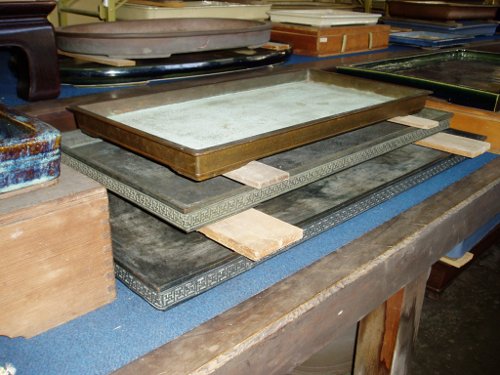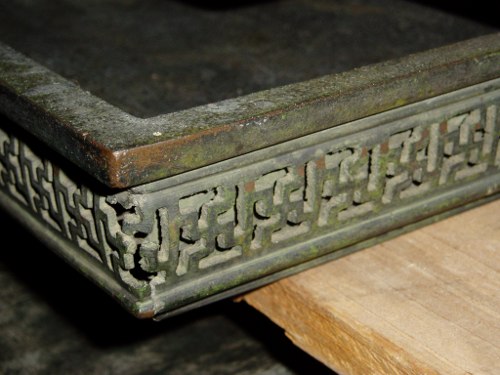In partial answer to the
"Some of What We Don't Know" question
"Was a bronze pen ever used as a container for a miniature landscape, possibly a dry garden?," we present the following:
Su Shi, aka Su Dongpo (1037-1101), literatus who mastered virtually all
literary and artistic forms, had at least three poems mentioning container landscapes. One of his favorite
objects, a bronze basin given to him by Korean diplomats, probably in 1072 when he was a magistrate in Hangchou,
held a green rock he acquired in 1092 in Yangchou which was in the shape of inverted hu and had a cavity
that penetrated through to the back of the stone. The pebbles surrounding the base of the rock were collected
by him from the beaches of Tengchou, on the Shantung coast in 1085. For Su Shih, the shape of the rock
recalled Chou-chih, one of the sacred mountains of Daoism which was immortalized by the Tang poet Du Fu.
(From Fong, Wen C. and James C.Y. Watt Possessing the Past, Treasures from the National Palace Museum, Tapei
(New York: The Metropolitan Museum of Art and Taipei: National Palace Museum; 1996), pp. 463-464.)
"These [miniature] landscape gardens, as we
may call them, are even constructed within the narrow limits of bronze
or porcelain basins, and the jardinieres which are placed in the rooms
often contain a whole rocky landscape, with mosses, various grasses, small bamboos and dwarf trees."
(From the Official Catalogue of the Japanese Section, International Exhibition, 1876; Philadelphia:
Published by the Japanese Commission, Printed by W.P. Kildare, 1876, pg. 115.)
Under such miniature presentment, trees and plants must be dwarfed to bear
proper relations to the dwarfed valleys and rocks. To such an
extent is this copying of nature in little carried by enthusiastic
gardeners that a rocky landscape, with its heights and level spaces and trees, is wrought out,
with nice attention to proportions, within the limits of a great bronze basin."
(From Mitchell, Donald G. "In and about the Fair"
in Scribners monthly, an illustrated magazine for the people,Volume 13, Issue 1, November 1876, pg. 118.)
"A few years ago the pigmy trees of Japan were comparatively unknown in
this country. Nowadays their importation has increased to a considerable extent, and one experiences less
amazement at sight of the microscopically perfect growths, the veriest pigmies of cedar, pine, oak, or maple, from
a few inches to two or three feet in height, enjoying an evidently healthy though circumscribed existence in the
china vases or bronze pans which help to make up such a charming scheme of decoration."
(From "The Cult of the Pigmy Tree," The House Beautiful,
Vol. X, No. 4, September 1901, pg. 254.)
|

